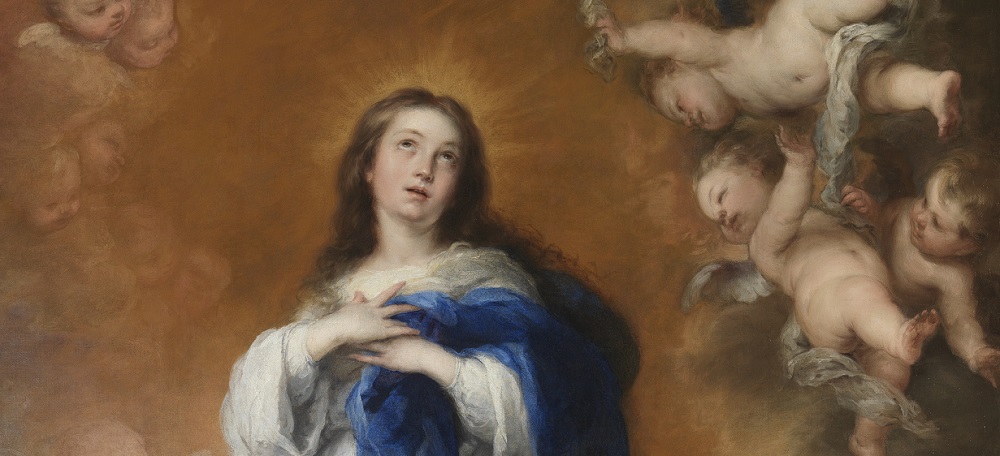The Church’s teaching on the Blessed Virgin Mary’s Immaculate Conception was defined only after centuries of tense theological debate.
It was proclaimed to be dogma — doctrine pertaining to divinely revealed truth, which Catholics are obliged to believe — in 1854. Analyzing the historical roots of this feast aptly demonstrates the dynamic and pragmatic nature of our Church and the development of doctrine.
Historical Development
As with all Church teachings, one must investigate what Scripture says concerning this dogma. But the Bible does not speak of the Immaculate Conception in a direct way. Before the 1854 definition, many had pointed to Luke 1:28, “Hail, full of grace” (RSV), to say that Mary was always filled with grace and thus without sin.
Medieval theology was dominated by conflict regarding Mary’s Immaculate Conception. While the feast had spread in some areas of Western Europe, Rome neither celebrated nor officially recommended it. Since the Vatican did not sanction the feast, many bishops and theologians opposed the doctrine as an “innovation.”
St. Bernard of Clairvaux and St. Thomas Aquinas were the two main theological opponents of the doctrine of the Immaculate Conception. In 1140, Bernard famously illustrated the prevailing negative attitude toward concupiscence — for Bernard it was unthinkable that the Holy Spirit had been involved in anything so inherently “evil” as the conception of a child. Thomas Aquinas used the doctrine of universal redemption to argue against the concept of the Immaculate Conception, saying that if Mary had not been stained by original sin then it would detract from Christ’s dignity as the savior of all people.
Nonetheless, the objections of Bernard and Thomas did not win the theological debate. The argument of Bernard concerning concupiscence was rendered useless with a renewed understanding of human sexuality. And Blessed John Duns Scotus, a Franciscan from Oxford University, answered the objections of Aquinas by arguing that Mary’s preservation from original sin did not remove her dependence on Christ’s redemptive work. Rather, more than anyone, Mary needed Christ as her redeemer since she would have contracted original sin if the grace of Christ had not prevented it from happening.
Through the late Renaissance period and moving into the modern era, the doctrine of the Immaculate Conception became more acceptable. The Council of Basel, called in 1431, stated that Mary, by a special gift of grace, had never been subject to original sin. Furthermore, the council declared that such a belief was “pious and agreeable to the worship of the Church, the Catholic faith and the teaching of Holy Scripture.” Later, Pope Sixtus IV, another Franciscan, prescribed the feast for the diocese of Rome in 1477, but did not command it. Pope Clement XI prescribed the feast for the whole Church in 1708, to be celebrated on Dec. 8.
Confirmation in the 19th Century
Many developments regarding the definition of Mary’s Immaculate Conception took place in the 19th century. In 1830, the Blessed Virgin Mary appeared to St. Catherine Labouré, revealing to her an image of what is referred to as the “Miraculous Medal.” The medal was forged as a remembrance of this apparition, and contains the words, “O Mary, conceived without sin, pray for us who have recourse to thee.” This popular sacramental affirms the sinlessness of Mary and her Immaculate Conception.
In 1846, the U.S. bishops, meeting in Baltimore, unanimously selected the Blessed Virgin Mary, under her title of the Immaculate Conception, as the county’s patroness, which was approved by Pope Pius IX, who defined the dogma less than a decade later.
By his definition of the Immaculate Conception as a divinely revealed reality, Blessed Pius IX opted to do so without the aid of a council of bishops. The process began by asking for comments from bishops, religious orders and interested laity on the possibility of a definition concerning the Immaculate Conception. Despite some exceptions, the general response was favorable, and the Pope pronounced the dogma in 1854 — the first dogma so proclaimed outside an ecumenical council.
Blessed Pius IX’s initiative to define Mary’s perpetual sinlessness was given validity in 1858. That year Mary made a series of apparitions to the young French peasant girl St. Bernadette Soubirous at Lourdes. In the apparitions, Mary identified herself by stating, “I am the Immaculate Conception.” Once more, as with St. Catherine Labouré, Mary’s sinlessness had been verified by the supernatural.
After a lengthy history of development and supernatural support, Catholic doctrine proclaims that Mary was sinless from the time of her conception. This reality of the Faith is celebrated annually on Dec. 8 as the solemnity of the Immaculate Conception.
Father Richard Gribble, C.S.C., is a professor of religious studies at Stonehill College. He holds a Ph.D. from The Catholic University of America.

